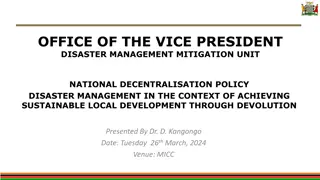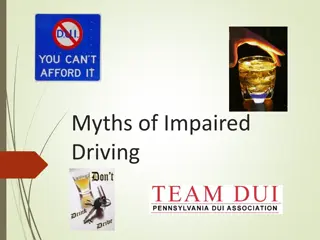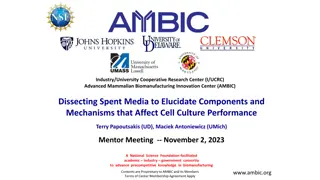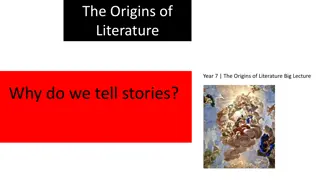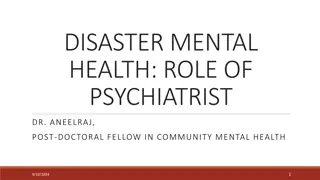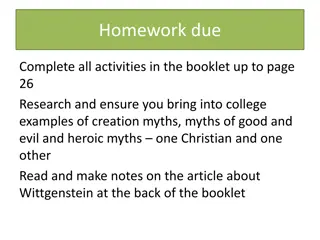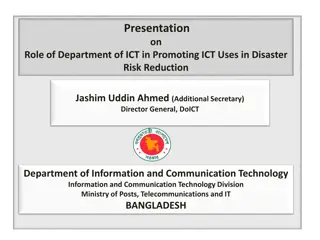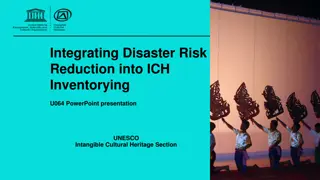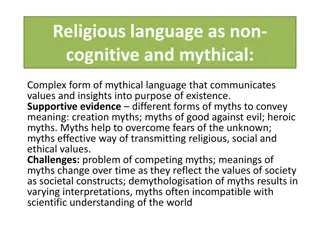Dissecting Disaster Behavior Myths: Insights from Dr. Dennis S. Mileti's Keynote
Delve into the exploration of disaster behavior myths through the enlightening keynote address by Dr. Dennis S. Mileti, a distinguished Professor Emeritus. Unravel the origins, perpetuation, and implications of these myths while debunking prevalent misconceptions about public response, safety perceptions, and attention-holding strategies in times of crisis.
Download Presentation

Please find below an Image/Link to download the presentation.
The content on the website is provided AS IS for your information and personal use only. It may not be sold, licensed, or shared on other websites without obtaining consent from the author. Download presentation by click this link. If you encounter any issues during the download, it is possible that the publisher has removed the file from their server.
E N D
Presentation Transcript
Dennis S. Mileti, Ph.D. Professor Emeritus University of Colorado at Boulder Keynote Address Policy Forum, Naval Postgraduate School Center for Homeland Defense and Security Monterey, CA: November 9, 2009 1
Youll Have Conversations With Yourself While I m Speaking: And they might sound something like this: He s wrong & I have evidence that proves it Request: Don t let internal dialogues distract you from listening We can talk about counterpoints later 2
Review Some Disaster Behavior Myths Discuss The Source Of Disaster Myths Address How Myths Are Perpetuated Implications Of Belief in Myths 3
People Believe Something Is True But its not They Think They Have Evidence For It: But they don t And They Won t Stop Believing It: No matter what others might say 4
Exist About Every Phase Of Disaster: Pre-impact During impact Post-impact Regarding All Disaster Actors: Public Response organizations Emergency workers 5
MYTH: Frighten the public Property values will decline Tourists and investors will stay away There are no tsunami (or shark) signs in Honolulu REALITY: Disasters happen to other people in other places People perceive safety, not risk Example: San Francisco s Marina District 7
MYTH: You can t hold the public s attention Warn people at risk in a few words Let the media handle the rest REALITY: Applies to advertising & undergraduate lectures Doesn t apply to warnings Warned people become information starved They ll find what they want to know someplace else 8
MYTH: People will panic (self over others) Individual motives replace social motives We didn t issue a warning to avoid panic REALITY: Social motives replace individual motives Actual panic is VERY rare Four conditions must exist: People in confined spaces Escape routes exist, not enough time for all to use them Think will die if don t leave People have to compete to live 9
MYTH: People will loot and steal Take valuables from dead neighbors Steal what evacuees left behind REALITY: People give to each other in disasters Free McDonald s hamburgers Share what they have to eat/drink with strangers Example: bread convergence in Soviet Armenia 10
MYTH: Emergency worker s wives (at home) become helpless, & forget how to drive First responders (men) have role conflict, abandon their jobs, & go home to rescue their helpless wives NRC has most NNPs in America train an extra 20% REALITY: 95% of people rescued in urban earthquakes rescued by other surviving victims (emergent work groups) Role strain & succession occurs Multiple shifts of first responders reported in at TMI 11
MTYH: People do wrong things because of fear: Run outside in earthquakes Dash to schools to get their kids Shadow evacuation (safe people evacuate) REALITY: People do what they think is rational TMI over-evacuation was actually rational 12
MYTH: Evacuees in cars fight on highways & in gas stations Martial law & National Guard are needed to maintain law and order REALITY: Accidents goes down in evacuations Spousal abuse goes down (at least initially) Crime all but disappears What does go up is alcohol consumption: It s a coping mechanism 13
Myths Synthesis : Disasters strip the thin veneer of civilization from humanity & its everyone for themselves The public = the problem Reality Synthesis: The thin veneer of civilization is actually, albeit temporarily, strengthened The public = part of the solution 14
Inherently Sociological Questions Most Disaster Myths Are Decades Old: Sociological papers on the topic abound and date back to the 1950s, 1960s, and 1970s Search for disaster myths on Google & you can access many of those papers Some Myths Have Existed For Centuries 15
Most People Know Disasters Change Our Physical Environment: Rubble, destruction, collapsed & burnt buildings Everyone can see it Most People Don t Know Disasters Also Change Our Social Environment: The social glue that holds society together is transformed by disaster Most non-social scientists can t see it 16
Is Pretty Much Applicable To Everyone: Transcends time, culture & space Holds Regardless of Disaster Agent: Natural, technological, terrorism, etc. Part Of Many Freshman Sociology Courses 17
Emergencies: CAPACITY: of local emergency response not exceeded GAPS: no service delivery gaps CONVERGENCE: of external response organizations absent Disasters: CAPACITY: of local emergency response exceeded GAPS: emergent public response due to service delivery gaps CONVERGENCE: external responders quick to arrive Catastrophes: CAPACITY: of local emergency response exceeded GAPS: emergent public response due to service delivery gaps CONVERGENCE: external responders slower to arrive 18
Service Delivery Gaps Focus: Emergent public response Emergent Public Response Reinforce: Transformation of the social order Transformation Of The Social Order Means: The social glue that holds society together shifts The blueprint for interpersonal interaction alters 19
NORMAL DISASTER 21
Normal Social Order: Social glue = secondary relationships Transformation (normal to disaster): Empathy, guilt, disaster syndrome Disaster Social Order: Social glue = collective behavior (like intense primary relationships) Transformation (disaster back to normal): Convergence from the outside Mutual aid, FEMA, National guard, etc. Goals achieved 22
DISASTER CHAOS 23
Transformation (disaster to chaos): Overwhelm: can t achieve goals Isolation: no convergence Theoretically possible: only observed twice in history Chaos Social Order: No social glue, no relationships, withdrawal, society ends Transformation (chaos to disaster): Convergence from the outside Mutual aid, FEMA, National guard, etc. Goals not yet achieved Transformation (disaster to normal): Goals achieved 24
NORMAL DISASTER CHAOS 25
Viewing Disaster Interaction Through Normal Non-Disaster Eyes: Outsiders (not transformed) at a disaster scene: New social glue/order looks different & call it chaos Pre-disaster what would you do if surveys Has Always Happened & Always Will Lectures Like This Will Always Be Needed 27
What Weve Just Gone Over Is: Is pretty close to a cultural universal: It occurs independent of time, space & culture Is Part Of Being Human: There may have been species of humans that didn t respond to disasters this way: But they died out 28
Disaster Myths Are Passed Along: Person to person & Generation to generation As Folk Knowledge: Through popular culture Via The Same Mechanism That Transmits All Folk Wisdom Elements Including: Stereotypes, values, mores, gender roles, etc. Here Are Some Examples .. 30
Myths Sell Movie Tickets, Reality Doesnt: MYTH: Disaster cause the thin veneer of civilization to be stripped from humanity and its everyone for themselves, e.g., panic, role abandonment & looting REALITY: Disasters bring out the best in people, not the worst Many Believe What They See In Movies: Even some emergency managers 31
Media Can (not always) Exaggerate: Initial death estimates typically twice reality TV anchor stage during Loma Prieta Near panic at Kiev train station in Chernobyl Chaos everywhere often reported After Its Over Most Mayors Exclaim: I m proud of my community we re unique When the chips were down everyone here came together to help each other: (IMPLYING: unlike the rest of you slimy panic-prone American looters ) 32
Rare Exceptions To General Patterns Exist: E.g., looting, aberrant behavior & role abandonment in New Orleans during Hurricane Katrina Become Evidence For The Myths: Legitimate the myths Validate policies based on myths One good exception can negate 100s (maybe 1,000s) of case events to the contrary 33
Misplaced Resources? Poorly Conceived Policies & Programs? Under Funded Solutions? Opportunities Overlooked? 35
Emergencies - Disasters - Catastrophes? Particularly Since We Know That: Emergencies, disasters, and catastrophes are inherently different phenomena And since they re different, why do we call it all emergency management ? 36






